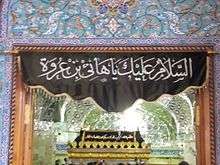Great Mosque of Kufa
| Great Mosque of Kufa | |
|---|---|
|
The mosque in 2014 | |
| Basic information | |
| Location | Kufa, Iraq |
| Geographic coordinates | 32°01′43″N 44°24′03″E / 32.02861°N 44.40083°ECoordinates: 32°01′43″N 44°24′03″E / 32.02861°N 44.40083°E |
| Affiliation | Islam |
| Municipality | Najaf Governorate |
| Website | Al-Kufa Mosque |
| Architectural description | |
| Completed | 670 AD |
| Specifications | |
| Dome(s) | 1 |
The Great Mosque of Kufa, or Masjid al-Kūfa (Arabic: مسجد الكوفة المعظم), or Masjid-al-Azam located in Kūfa, Iraq, is one of the earliest mosques in the world. The mosque, built in the 7th century, contains the remains of Muslim ibn ‘Aqīl - first cousin of Husayn ibn ‘Alī, his companion Hānī ibn ‘Urwa, and the revolutionary Mukhtār al-Thaqafī.[1]
Dimensions
Today the area of the building measures approximately 11,000 m2.[2]
The mosque contains nine sanctuaries and four traditional locations. It has four minarets and is served by five gates.[2]
Renovation
The 52nd Da'i al-Mutlaq of Dawoodi Bohra Syedna Mohammed Burhanuddin undertook the renovation of the mosque, which was then completed in early 2010. It has many special features:
- The mosque has been decorated with gold and silver and precious stones such as diamonds, rubies and in every corner of the mosque one will find Ya Ali written.
- The Qibla in which maula Ali Ibn Abi Talib was martyred has been made with a gold zari. It is composed of gold, silver, rubies, diamonds.
- The whole interior of the Mosque has verses of the Quran surrounded in gold in Arabic calligraphy.
- In the section of the qibla there are tear shaped engravings in marble, bordered with gold and rubies.
- The whole mosque has marbles and tiles which have been brought from Greece. These tiles are also found at Kabatullah in Mecca. The special feature of these tiles is that it is cool in bright sunlight and in summers, especially in places with a dry climate like in Iraq.
- Special Rugs have been brought from Iran which are used inside the mosque.
Significance

The Mosque is revered for many reasons:
- It was the place where ‘Alī was fatally wounded by a poison-coated sword while prostrating in the Fajr prayer.[3]
- Contains the tombs of Muslim ibn ‘Aqīl, Hānī ibn ‘Urwa, and Mukhtār al-Thaqafī
- There are markers within the mosque indicating the locations for where the court of ‘Alī used to preside, where he performed miracles, and where ‘Alī ibn Husayn and Ja‘far as-Sādiq used to perform salat
- Islamic traditions relate that it was the dwelling place of Noah and that this was the place where he built the Ark[4]
- According to Shia belief, it was from this mosque that the diluvium of Noah started submerging earth, as well as being the place from where the water was re-absorbed [5] - also marked within the Mosque
- Imām Ja‘far as-Sādiq said that up to twelve miles of land in all directions from the mosque are blessed by its holiness.[4]
- Ja'far al-Sadiq was also recorded as remarking that the "mosque in Kufa is superior to that of Jerusalem"[6] and that "performing two prostrations of prayer here would be better for me than ten others at any mosque."[4]
- There are also Shia traditions which state that performing one prayer in this mosque is the same as having performed one thousand prayers elsewhere,[7] and performing one obligatory prayer here is equal to having performed an accepted Hajj
[8] - The secretariat of Al-Kufa Mosque and its shrines describes the mosque as being one of the sole four dignified mosques to which Muslims must travel, and that it comes in third place after the Kaaba and the mosque of Prophet."[9]
See also
References
- ↑ "Hundreds of thousands' Friday assemblage in Masjid-e-Uzma Kufa". Jafariyanews.com. Retrieved 20 November 2008.
- 1 2 "General Facts and Numbers". The Official Website of Secretariat of Al-Kufa Mosque and it Shrines. Retrieved 2009-03-01.
- ↑ Tabatabaei, Sayyid Mohammad Hosayn (1979). Shi'ite Islam. Suny Press. p. 192. ISBN 978-0-87395-272-9.
- 1 2 3 "The Establishment of the Mosque". The Official Website of Secretariat of Al-Kufa Mosque and it Shrines. Retrieved 2009-03-01.
- ↑ al-Qummi, Ja'far ibn Qūlawayh (2008). Kāmil al-Ziyārāt. trans. Sayyid Mohsen al-Husaini al-Mīlāni. Shiabooks.ca Press. pp. 66–67.
- ↑ Gold, Dore (2007). The Fight for Jerusalem. Regnery. p. 91. ISBN 978-1-59698-029-7.
- ↑ al-Qummi, Ja'far ibn Qūlawayh (2008). "8". Kāmil al-Ziyārāt. trans. Sayyid Mohsen al-Husaini al-Mīlāni. Shiabooks.ca Press. p. 47.
- ↑ al-Qummi, Ja'far ibn Qūlawayh (2008). "8". Kāmil al-Ziyārāt. trans. Sayyid Mohsen al-Husaini al-Mīlāni. Shiabooks.ca Press. p. 44.
- ↑ "The Establishment of the Mosque". The Official Website of Secretariat of Al-Kufa Mosque and it Shrines. Retrieved 2009-03-01.
It is the one the sole four dignified mosques, to which Muslims must travel, and it comes in the third place after the Mosque the Kaaba, the mosque of Prophet
External links
| Wikimedia Commons has media related to Great Mosque of Kufa. |

.jpg)
